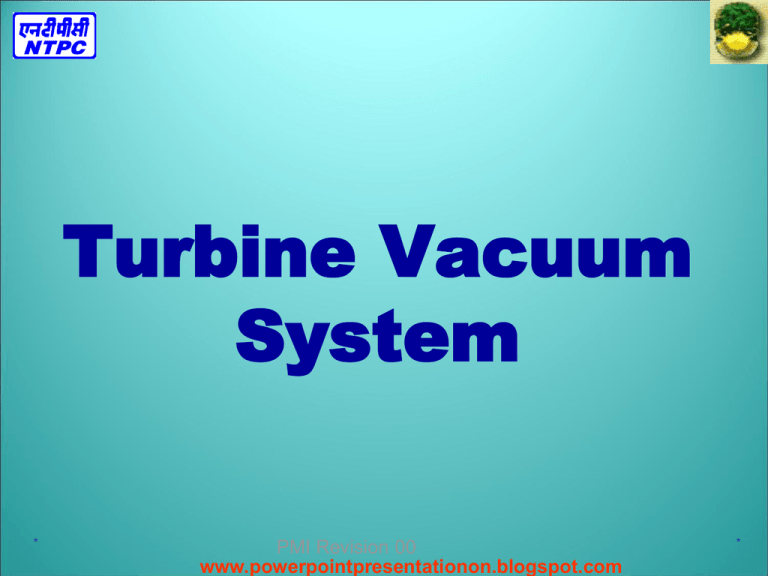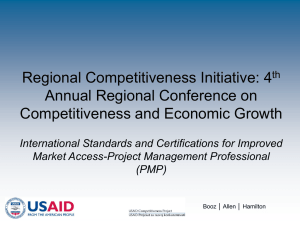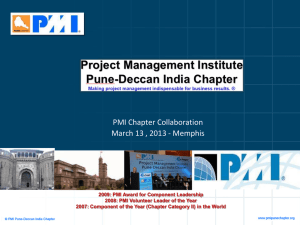Turbine Vacuum System
advertisement

Turbine Vacuum System * PMI Revision 00 www.powerpointpresentationon.blogspot.com * Presentation outline Why Vacuum system is required ? Parts of Vacuum system? Steam Ejectors Vacuum Pumps * PMI Revision 00 * Why is it required? * • The steam turbineThe steam turbine is a device to convert the heatThe steam turbine is a device to convert the heat in steamThe steam turbine is a device to convert the heat in steam to mechanical power. • Enthalpy drop across the turbine decides the work output of the turbine. For increasing this enthalpy drop across the turbine we need effective condenser vacuum system. • By condensing the exhaust steamBy condensing the exhaust steam of turbine, the exhaust pressure is brought down below atmospheric pressureBy condensing the exhaust steam of turbine, the exhaust pressure is brought down below atmospheric increasing the PMI Revision 00 pressure, * * PMI Revision 00 * Parts of Vacuum System • • • • * Condenser CW system Ejectors/Vacuum pumps Gland Sealing System PMI Revision 00 * Power Loss Due to Excess Back Pressure PMI Revision 00 CONDENSER The functions of condenser are: •To provide lowest economic heat rejection temperature for the steam. Thus saving on steam required per unit of electricity. •To convert exhaust steam to water for reuse for thus saving on feed water requirement. •De-aeration of make-up-pump water introduced in the condenser. •To form a convenient point for introducing make up water. PMI Revision 00 Steam Condenser • • • • • • • • • • Steam condenser is a closed space into which steam exits the turbine and is forced to give up its latent heat of vaporization. It is a necessary component of a steam power plant because of two reasons. It converts dead steam into live feed water. It lowers the cost of supply of cleaning and treating of working fluid. It is far easier to pump a liquid than a steam. It increases the efficiency of the cycle by allowing the plant to operate on largest possible temperature difference between source and sink. The steam’s latent heat of condensation is passed to the water flowing through the tubes of condenser. After steam condenses, the saturated water continues to transfer heat to cooling water as it falls to the bottom of the condenser called, hotwell. This is called subcooling and certain amount is desirable. The difference between saturation temperature corresponding to condenser vaccum and temperature of condensate in hotwell is called condensate depression. PMI Revision 00 PMI Revision 00 A Device to Convert Dead Steam into Live Water Dead Steam Water ready to take Rebirth PMI Revision 00 PMI Revision 00 Two-Pass Surface Condenser PMI Revision 00 Thermal Processes Occurring in Condensers • The condenser never receives pure seam from the turbine. • A mixture of steam and non-condensable gases (Air-steam mixture) enters the condenser. • The ratio of the quantity of gas that enters the condenser to the quantity of steam is called the relative air content. •The value of ε, depends on type, capacity, load and design dimensions of the condenser plant. PMI Revision 00 Condenser •Steam from last stage of LPT Exhausts on condenser tube • condensation of steam takes place •Water collected in hot well * PMI Revision 00 * Inside a Shell and tube condenser PMI Revision 00 engineering-resource.com Surface Condenser ( shell and tube) A surface condenser is basically a shell and tube heat exchanger with phase change. The main parts of a condenser are as follows. • 1-SHELL • 2-TUBES • 3-TUBE SHEETS PMI Revision 00 engineering-resource.com Shell of the Condenser • The shell is the outer most body of the condenser • shell is fabricated from fairly thick carbon steel plates. • Due to its large size the shell is sufficiently strengthened or stiffened internally with carbon steel plates to give sufficient rigidity for the shell proper. • The shell also gives support to number of intermediate support plates for the long tubes, depending on the size of the condenser. • At the same time the intermediate tube support plates allow for the free movements of tubes in all directions particularly lengthwise due to expansionAt the same time the intermediate tube support plates allow for the free movements of tubes in all directions particularly lengthwise due to expansion and contraction occurring during operation. * PMI Revision 00 * CONDENSER SUPPORT • The whole condenser is supported on heavy springs, mounted on steel sole plates at suitable places on the concrete foundation • At the bottom of the shell where the condensate is allowed to collect, a sump (often referred to as the hotwell) is provided. • This sump is common to both the halves but separated by a partition wall in the middle up to the height of the bottom row of tubes. • The inside of shell and outside the tubes as a whole remains under vacuum under normal operating conditions. Inside the tubes the cooling or circulating water passes through. * PMI Revision 00 * InInorder ordertotoallow allow expansion along the expansion along the height, height,the thecondenser condenser isissupported supportedon on springs springsspecially specially design designtototake takeofofload load fig. fig.5.9 5.9 PMI Revision 00 Air Zone • Inside the shell, a central or side portion longitudinally is separated by an outer shield except at the bottom. This partition is called the Air zone. • All the gases released in the condenser due to cooling are taken out via these air zone tubes. • From a suitable portion of this air zone inside the shell an air vent pipe is taken out and brought out of the shell for connection to an air extraction device. * PMI Revision 00 * Tube Sheets • At each end of the shell, tubeAt each end of the shell, tube sheet of sufficient thickness is provided, with holes for the tubes to be inserted and rolled. • To take care of length wise expansionTo take care of length wise expansion of tubes some designs have expansion joint between the shell and the tube sheet allowing the latter to move longitudinally. * PMI Revision 00 * Condenser tubes are secured to the end tubes plates expanding and flanging of tube ends which provides very good arrangement against penetration of circulating water in to the steam space. Water Boxes • The tube sheet at each end with tube ends rolled, for each half condenser is enclosed in a fabricated box known as water box. • These water boxes on inlet side will also have big size flanged connections for cooling water inlet at lower level for butterfly valves. • small vent pipe with hand valve small vent pipe with hand valve for air venting at higher level, and hand operated drain valve at bottom to drain the water box for maintenance. • Similarly thermometer pockets are located at inlet and outlet pipes for local measurements cooling water temperature. * PMI Revision 00 * The tubes have been so arranged that there is equal distribution of steam on the tube nest with minimum resistance to steam flow. PMI Revision 00 Condenser tubes….. Non-condensable gases are continuously sucked with the help of steam ejectors With a view to allow a relative expansion between tubes and the body of the lower part, lens type compensator has been provided in the body it self at rear water box end. This arrangement prevents deformation of the body and damage to connections between tubes and end plates * PMI Revision 00 * Condensate Depression • The temperature of condensate is always a few degrees lower than the coincident condensing steam temperature. • Subcooling of condensate is undesirable on two accouts: • It lowers the thermodynamic efficiency of the power cycle. • It enhances the propensity of the condensate to reabsorb non-condensibles. PMI Revision 00 Condenser Pressure, mm of Hg Effect of Air Leakage on Condenser Pressure Air pump controlling the back pressure Condenser controlling the back pressure Air pump controlling the back pressure Condenser controlling the back pressure 10 30 40 50 20 Cooling water Inlet Temperature CONDENSER • Evolution of Tube material Cu-Zn Cu-Ni SS304 / Titanium : Inert to all kind of Water PMI Revision 00 LIMITATIONS •Corrosion •Expansion •Arrangement engineering-resource.com PMI Revision 00 TYPES OF FAILURES IN CONDENSER • Impingement attack :Erosion due to high inlet water velocity or high localized water velocity • Bio Fouling • Stress Corrosion • Corrosion Fatigue • Deposit attack • Steam Side Ammonia Corrosion PMI Revision 00 ONLINE CLEANING OF CONDENSER * PMI Revision 00 * PMI Revision 00 * PMI Revision 00 * CW system CW pumps supply cooling water to condensers CW maintains vacuum in condensers CW flows through condensers tubes * PMI Revision 00 * Hot water in (95°F) Fan motor Air in 95°F dry bulb, 78°F wet bulb Air out Cooled water out (85°F) Mechanical Draft Cooling Tower PMI Revision 00 * PMI Revision 00 * STEAM EJECTORS • Air and water vapor are removed from the main steam condenser, enter the 1st stage ejector and are compressed to the interstage pressure by means of the high pressure motive steam. • The load and motive steam are discharged to the inter condenser and a portion of the water vapor load and motive steam are condensed by condensate from the main condenser. • Non-condensibles and associated water vapor are removed from the inter condenser by the 2nd stage ejector. * PMI Revision 00 * STEAM EJECTORS Discharge to condenser Nozzle Convergent divergent diffuser Motive steam * Non condensibile gases and PMI Revision 00 water vapour from condenser * STEAM EJECTORS • Multistage condensing ejector systems can be designed to operate at any condenser pressure and designs are not limited by the available cooling water temperature to the intercondenser (condensate cooled systems are common). • These systems have no moving parts, are the most reliable, require the least maintenance of all venting systems, and are the least expensive in initial cost. • Once equipment is built for a given motive steam pressure that pressure must be maintained or the ejector will become unstable and lose vacuum. * PMI Revision 00 * STEAM EJECTORS * PMI Revision 00 * EJECTORS • MAIN AIR EJECTOR • STARTING AIR EJECTORS * PMI Revision 00 * Ejectors * PMI Revision 00 * VACUUM PUMPS • The liquid-ring vacuum pump is a specific form of rotary positive-displacement pump utilizing liquid as the principal element in gas compression. • The working parts of the liquid ring vacuum pump consist of a multi-bladed impeller mounted eccentrically in a round casing which is partly filled with liquid. As the impeller rotates, the liquid is thrown by centrifugal force to form a liquid ring which is concentric with the periphery of the casing. • * PMI Revision 00 * LRVP Suction port Discharge port Casing Impeller Gas vapour mixture * PMI Revision 00 Liquid ring * LRVP • In addition to being the compressing medium, the liquid ring absorbs the heat generated by compression and friction, absorbs any liquid slugs or vapor entering with the gas stream, and condenses water vapor entering with the gas. • A closed loop (or total recirculation) seal system is commonly used. The seal water temperature warmer than the cooling water to the pump heat exchanger, which is normally taken from the same source as the condenser cooling water (CW or ARCW). * PMI Revision 00 * LRVP vent Non condensible gases and water vapour from condenser Separator Makeup LRVP Cooling water Seal water Seal cooler * LiquidPMI ring vacuum pump system Revision 00 * LRVP • The vacuum attainable by a liquid ring vacuum pump is limited by the vapor pressure of the seal fluid. • As the operating vacuum approaches the vapor pressure of the seal, more and more of the seal fluid will “flash” into vapor. • The capacity of the liquid ring vacuum pump is reduced as more of the impeller space is occupied by vapor from the seal fluid, leaving less space available to accept the incoming load. • If allowed to continue, cavitation will occur inside the pump, resulting in damage to internal surfaces, and preventing the pump from achieving greater vacuum levels. * PMI Revision 00 * THANK YOU * PMI Revision 00 *







